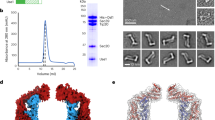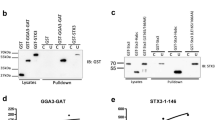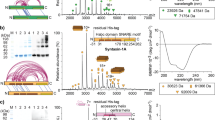Abstract
SNARE proteins are crucial for intracellular membrane fusion in all eukaryotes. These proteins assemble into tight complexes that connect membranes and may induce fusion. The crystal structure of the neuronal core complex is represented by an unusually long bundle of four α-helices connected by 16 layers of mostly hydrophobic amino acids. Here we report the 1.9 Å resolution crystal structure of an endosomal SNARE core complex containing four SNAREs: syntaxin 7, syntaxin 8, vti1b and endobrevin/VAMP-8. Despite limited sequence homology, the helix alignment and the layer structure of the endosomal complex are remarkably similar to those of the neuronal complex. However, subtle variations are evident that characterize different SNARE subfamilies. We conclude that the structure of the SNARE core complex is an evolutionarily conserved hallmark of all SNARE complexes and is intimately associated with the general role of SNAREs in membrane fusion.
This is a preview of subscription content, access via your institution
Access options
Subscribe to this journal
Receive 12 print issues and online access
$189.00 per year
only $15.75 per issue
Buy this article
- Purchase on Springer Link
- Instant access to full article PDF
Prices may be subject to local taxes which are calculated during checkout




Similar content being viewed by others
References
Jahn, R. & Südhof, T.C. Annu. Rev. Biochem. 68, 863–911 (1999).
Bock, J.B., Matern, H.T., Peden, A.A. & Scheller, R.H. Nature 409, 839–841 (2001).
Brünger, A.T. Curr. Opin. Struct. Biol. 11, 163–173 (2001).
Hanson, P.I., Heuser, J.E. & Jahn, R. Curr. Opin. Neurobiol. 7, 310–315 (1997).
Weber, T. et al. Cell 92, 759–72 (1998).
Sutton, R.B., Fasshauer, D., Jahn, R. & Brünger, A.T. Nature 395, 347–353 (1998).
Fasshauer, D., Sutton, R.B., Brünger, A.T. & Jahn, R. Proc. Natl. Acad. Sci. USA 95, 15781–15786 (1998).
Fasshauer, D., Antonin, W., Margittai, M., Pabst, S. & Jahn, R. J. Biol. Chem. 274, 15440–15446 (1999).
Yang, B. et al. J. Biol. Chem. 274, 5649–5653 (1999).
McNew, J.A. et al. Nature 407, 153–159 (2000).
Patel, S.K., Indig, F.E., Olivieri, N., Levine, N.D. & Latterich, M. Cell 92, 611–620 (1998).
Ungermann, C. et al. J. Cell Biol. 145, 1435–1442 (1999).
Ungermann, C., Sato, K. & Wickner, W. Nature 396, 543–548 (1998).
Peters, C. et al. Nature 409, 581–588 (2001).
Antonin, W. et al. EMBO J. 19, 6453–6464. (2000).
Katz, L., Hanson, P.I., Heuser, J.E. & Brennwald, P. EMBO J. 17, 6200–6209 (1998).
Fischer von Mollard, G. & Stevens, T.H. J. Biol. Chem. 273, 2624–2630 (1998).
Saifee, O., Wei, L. & Nonet, M.L. Mol. Biol. Cell 9, 1235–1252 (1998).
Otwinowski, Z. & Minor, W. Methods Enzymol. 276, 307–326 (1997).
Kissinger, C.R., Gehlhaar, D.K. & Fogel, D.B. Acta Crystallogr. D 55, 484–491 (1999).
Brünger, A.T. et al. Acta Crystallogr. D 54, 905–921 (1998).
McRee, D.E. J. Struct. Biol. 125, 156–165 (1999).
Laskowski, R.A., MacArthur, M.W., Moss, D.S. & Thornton, J.M. J. Appl. Crystallogr. 26, 283–291 (1993).
Kraulis, P.J. J. Appl. Crystallogr. 24, 946–950 (1991).
Esnouf, R.M. J. Mol. Graph. Model. 15, 132–134 (1997).
Merritt, E.A. & Bacon, M. Methods Enzymol. 277, 505–524 (1997).
Schneider, T.R. Acta Crystallogr. D 56, 714–721 (2000).
Kabsch, W. Acta Crystallogr. A 32, 922–923 (1976).
Collaborative Computational Project, Number 4. Acta Crystallogr. D 50, 760–763 (1998).
Acknowledgements
This work was supported by grants from the Deutsche Forschungsgemeinschaft and from the Fonds der Chemischen Industrie. We thank G. Fischer von Mollard, G. Sharp and S. Pabst for critically reading the manuscript.
Author information
Authors and Affiliations
Corresponding author
Ethics declarations
Competing interests
The authors declare no competing financial interests.
Rights and permissions
About this article
Cite this article
Antonin, W., Fasshauer, D., Becker, S. et al. Crystal structure of the endosomal SNARE complex reveals common structural principles of all SNAREs. Nat Struct Mol Biol 9, 107–111 (2002). https://doi.org/10.1038/nsb746
Received:
Accepted:
Published:
Issue Date:
DOI: https://doi.org/10.1038/nsb746
This article is cited by
-
New insights into the mechanism of storage protein biosynthesis in wheat caryopsis under different nitrogen levels
Protoplasma (2020)
-
Inside(sight) of tiny communicator: exosome biogenesis, secretion, and uptake
Molecular and Cellular Biochemistry (2020)
-
v-SNARE function in chromaffin cells
Pflügers Archiv - European Journal of Physiology (2018)
-
Cryo-EM structures of the ATP-bound Vps4E233Q hexamer and its complex with Vta1 at near-atomic resolution
Nature Communications (2017)
-
All-atom simulations and free-energy calculations of coiled-coil peptides with lipid bilayers: binding strength, structural transition, and effect on lipid dynamics
Scientific Reports (2016)



